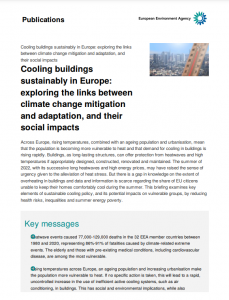Cooling buildings sustainably in Europe
 On November 10th, 2022 the European Environment Agency released the briefing: “Cooling buildings sustainably in Europe: exploring the links between climate change mitigation and adaptation, and their social impacts”.
On November 10th, 2022 the European Environment Agency released the briefing: “Cooling buildings sustainably in Europe: exploring the links between climate change mitigation and adaptation, and their social impacts”.
The document explores the links between climate change adaptation and mitigation, and the health and social justice aspects of cooling Europe’s buildings. It focuses specifically on residential buildings. The briefing is based on a literature review by Ramboll commissioned by the EEA, discussions held with members of the European Environment Information and Observation Network (Eionet), input from individual experts and information from other EEA publications.
Key messages
- Heatwave events caused 77,000-129,000 deaths in the 32 EEA member countries between 1980 and 2020, representing 86%-91% of fatalities caused by climate-related extreme events. The elderly and those with pre-existing medical conditions, including cardiovascular disease, are among the most vulnerable.
- Rising temperatures across Europe, an ageing population and increasing urbanisation make the population more vulnerable to heat. If no specific action is taken, this will lead to a rapid, uncontrolled increase in the use of inefficient active cooling systems, such as air conditioning, in buildings. This has social and environmental implications, while also increasing energy use.
- Europeans spend approximately 80%-90% of their time indoors. Buildings, as long-lasting structures, can protect occupants from the impacts of heat at low energy costs, if appropriately designed, constructed, renovated and maintained.
- The deep energy renovation of building envelopes can improve the resilience of buildings, reduce the amount of energy used for cooling and decrease greenhouse gas emissions. Doing so while also targeting vulnerable groups would minimise climate change impacts on health, reduce inequalities and alleviate summer energy poverty.
- If active cooling is necessary (e.g. because of long heatwaves and/or critical health issues), cooling systems should be as efficient as possible and equitably accessible by vulnerable and other groups.
- Key elements of a sustainable cooling strategy include tailoring to local contexts, promoting urban cooling solutions, prioritising investment in passive cooling techniques, using active cooling systems rationally and moderately, and developing low-energy cooling systems that are suited to future warmer climates.
- The current EU policy landscape — including the EU’s renovation wave, ‘Fit for 55’ package of proposals, the EU climate adaptation strategy and the Mission on Adaptation to Climate Change — offers key opportunities to ensure sustainable cooling solutions, social justice and greater resilience. Taking into account future climate and cooling needs, energy efficiency renovation is of central importance to control future summer energy demand.
The document is freely accessible at: https://www.eea.europa.eu/publications/cooling-buildings-sustainably-in-europe
Source: European Environment Agency
